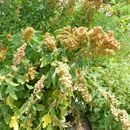Brief Summary
provided by EOL authors
Chenopodium quinoa, quinoa, is an annual herbaceous plant in the Amaranthaceae (amaranth family, but formerly placed in Chenopodiaceae, the goosefoot family) that originated in the Pacific slopes of the Andes in South America and were cultivated and used by the Inca people since 5,000 B.C. and was the most important cultivated food in the region when Europeans arrived. Although used like a cereal or grain, quinoa is an achene (a seed-like fruit with a hard coat). It was discovered as a health food by North Americans and Europeans in the 1970s, and has increased dramatically in popularity in recent years because it is gluten-free and high in protein. Quinoa is a fast-growing plant, up to 2 m (6 ft) tall, with alternate, coarsely toothed, triangular to ovate leaves; the plant is similar in appearance to the common North American weed (and wild-gathered food plant) C. album, lamb’s-quarters or goosefoot. Numerous inconspicuous flowers are borne in dense terminal clusters along with smaller axillary inflorescences (where leaves join stems) in the upper half of the plant. Each inflorescence may produce hundreds of small achenes, around 2 mm (1/16 in) in diameter. Achenes range in color from white or pale yellow to orange, red, brown, and black. Quinoa can be cooked to produce a fluffy grain-like dish with a nut-like flavor, although the seed coats contain saponins, that convey a bitter flavor unless the achenes are rinsed and soaked before use. Quinoa is frequently used like a cereal grain, ground into flour that can be used in baked goods as a supplement to or partial replacement for wheat flour. It is also rolled into flakes or puffed and used in breakfast cereals. Quinoa was traditionally fermented into a beer-like beverage, chichi, by the Incas. The leaves can be used as a cooked vegetable, similar to spinach. Quinoa is grown for commercial harvest only in in Peru, Bolivia, and Ecuador, where it constitutes an important cash crop in some local areas. FAO estimates that the total production of quinoa in 2010 was 71,419 metric tons, harvested from 86,303 hectares. Production more than doubled from 1990 to 2000, and has increased more than 50% in the past decade. (Bailey et al. 1976, FAO 2012, Hedrick 1919, van Wyk 2005.)

